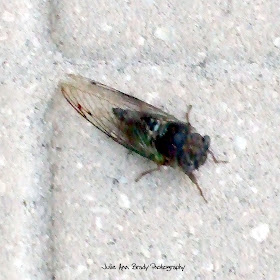 |
| Cicada of Leesburg, Florida |
Researching this cicada online, I found much mention of the 13-year and 17-year life cycles of those cicadas that will emerge in large quantities. "These periodical cicadas (Magicicada spp.) do not occur in Florida." The University of Florida has detailed information on the cicadas that are prevalent in Florida. Would you believe that there are reportedly 19 species of cicada prevalent in Florida?
It is interesting to note that male cicadas have the timbals or sound-producing organs while female cicadas are mostly mute. All cicadas can produce some soft sound by the rustling of their wing flips.
In an April 2016 First Coast News article online, it was reported that the 17-year cicadas were due to "emerge from their dirt feast and hit the east coast, including Florida, according to Martin Cook, a master gardener with the University of Florida IFAS extension office in Jacksonville."
 |
| Cicada of Leesburg, Florida |
17 Year and 13 Year Periodical Cicadas
Check out the page dedicated to the Magicicada periodical cicadas, aka 17-year and 13-year cicadas. There is plenty of fascinating information on the different broods. I wonder how they know what cicada is what? Like, how do you tell if that cicada was an annual one or was waiting for the 17th year to emerge?Got cicada mania yet? The annual cicadas of North America are discussed separately from the periodical cicadas.
Annual Cicadas of Florida
Trying to identify this particular cicada has been a bit of a challenge in that there are so many different species of cicadas that can be seen in Florida. Who seriously knew? Checking the information on the different Florida varieties, I came to two different species that might be this one.#15 which is the Neotibicen lyricen engelhardti (Davis, 1910). "The Dark Lyric Cicadas have the darkest coloration of all the Lyric cicadas. Their mesonotum is almost entirely dark brown/black. They have a 'soda-pop pull-tab' or keyhole shape on their pronotum."
#23 which is the Neotibicen tibicen tibicen (Linnaeus, 1758). It is referred to as the Swamp or Morning Cicada which "are known for their rounded, humped back. Their coloration varies from mostly black and some green to black, brown and green. Their collar is usually black, but can include green."
Can you identify this cicada of Leesburg Florida? Have you seen any cicadas in your yard? Hey, let me know ... I'm curious!
No comments:
Post a Comment